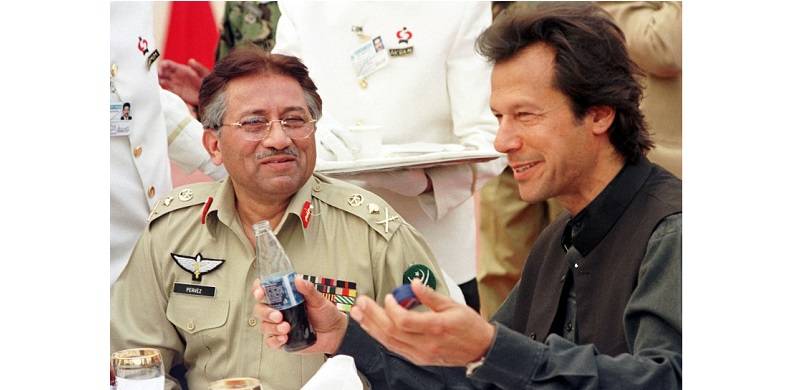
Soon after toppling the second Nawaz Sharif government in October 1999 in a military coup, General Parvez Musharraf posed for cameras at his house. He made sure to bring along two of his pet dogs, conscious of the presence of a large number of Western photographers and reporters gathered there.
This was a signal from him to the US and European governments: He wasn’t a ‘fundo’; and that Pakistan’s newly-built nuclear devises were in safe hands and in no danger of falling in the palms of groups of officers within the military who had become radicalised, first during the General Zia-ul-Haq dictatorship (1977-88) and then during the tumultuous ‘decade of democracy’ that followed Zia’s demise in 1988.
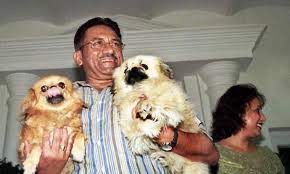 At the time of Musharraf’s coup, Pakistan was facing stringent economic sanctions imposed by the US and various European countries. The sanctions were largely slapped in 1998 when PM Nawaz Sharif decided to conduct nuclear tests after India had done the same. The US had offered billions of dollars to Pakistan to not react in this manner to India’s nuclear showmanship. But Nawaz went ahead with the tests. He knew that if he did not, he would be vehemently castigated by the populist Urdu press and Islamist forces, as well as by the military establishment.
At the time of Musharraf’s coup, Pakistan was facing stringent economic sanctions imposed by the US and various European countries. The sanctions were largely slapped in 1998 when PM Nawaz Sharif decided to conduct nuclear tests after India had done the same. The US had offered billions of dollars to Pakistan to not react in this manner to India’s nuclear showmanship. But Nawaz went ahead with the tests. He knew that if he did not, he would be vehemently castigated by the populist Urdu press and Islamist forces, as well as by the military establishment.
Musharraf immediately presented himself as someone who would eradicate the ‘unprecedented corruption’ witnessed during the ten years of ‘democracy’ that followed Zia’s demise, and reset the country’s politics and society by mitigating the influence of political Islam and sectarianism that had seeped into the body politic.
He proudly aired his admiration for the founder of the modern Turkish Republic and of Turkish secularism, Kamal Ataturk. He also exhibited similar admiration for former Pakistani military strongman and ‘modernist’ Ayub Khan (1958-69). There wasn’t any immediate reaction to this from a polity exhausted by economic sanctions and the constant three-way political conflict between Sharif’s PML-N, Benazir Bhutto’s PPP and the military establishment.
Cases of vicious sectarian and ethnic violence too had increased across the 1990s, even though their roots firmly lay in the policies of the Zia dictatorship. Musharraf’s coup was celebrated by most people, as reports of smiling men and women distributing sweetmeat began to come in.
Anti-Nawaz politicians weren’t too disturbed by the coup as well. To them, Nawaz had become incredibly arrogant, dictatorial and even delusional after his party had won a two-thirds majority in the 1997 election. Musharraf found himself in a rather comfortable spot, even though US and European governments decided to adopt a more cautious approach. The sanctions stayed.
The Supreme Court allowed Musharraf to rule for up to three years as ‘Chief Executive,’ and military chief. Despite the fact that he did not face any serious opposition from the major political parties who had become exhausted due to the hectic nature of the politics of survivalism that they had to play in the 1990s, Musharraf struggled to revive the economy and the trust of the country’s Western donors and trading partners.
Musharraf promised to ‘bring back’ an era during which – apparently – Pakistan was a modern, prosperous and liberal country. By this, Musharraf meant Ayub Khan’s Pakistan. But for this, he needed a functioning economy and trusting friends in the West. The opportunity to gain these presented itself in the most dramatic manner. 9/11 happened. Renegade Arab jihadists were involved, funded by the one of the most wanted Islamist terrorists, Osama bin Laden.
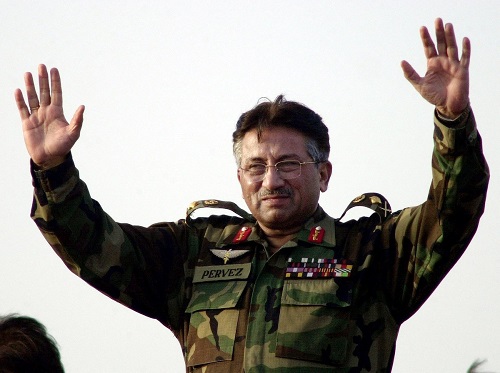
Osama and his men were operating from Afghanistan which, at the time, was being ruled by the first Taliban regime. That government had been installed by the Pakistani intelligence agencies in 1996. Only three countries were willing to recognise the reactionary Taliban regime: Saudi Arabia, the UAE and Pakistan.
The US government was livid at Osama’s audacity to attack US citizens inside the US. Hundreds perished during the 9/11 attacks. US President George W. Bush gave the green signal to American armed forces to invade Afghanistan, dislodge the Taliban, capture Osama, and install a government of anti-Taliban factions that controlled just ten percent of Afghan territory.
The involvement of Pakistan’s military and intelligence agencies was vital to the plan. Not only did Pakistan share a long border with Afghanistan, but it was heavily involved in Afghan politics after the departure of Soviet troops from Kabul in the late 1980s. Musharraf agreed to facilitate Bush. Pakistan was desperate to renew its relations with the US and European Union countries. What’s more, Pakistan’s involvement would also mean a windfall of aid from the US and the lifting of the 1998 sanctions.
With relations with European countries and US suddenly improving, sanctions ending and aid starting to roll in, Musharraf was ready to consolidate his position. He had already got himself ‘elected’ as President through a referendum in April 2001, a referendum which he himself joked wasn’t quite transparent. But after 9/11 in September 2001, and renewal of US and European aid and support, Musharraf began to construct a political party which he wanted to dominate the new parliament and provide the President a plethora of constitutional powers.
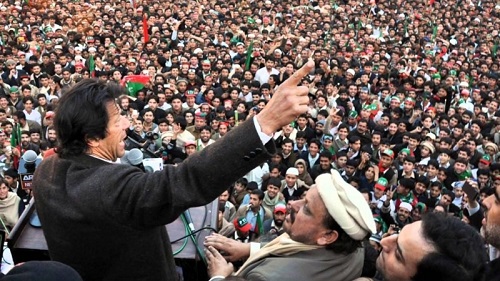 Two men, the moderate Barelvi cleric Tahir-ul-Qadri and former-cricket-star-turned-politician Imran Khan, offered themselves to become President Musharraf’s prime minister. Both were heading tiny parties. Musharraf asked them to contest the coming parliamentary election. Meanwhile, Musharraf busied the intelligence agencies to accommodate the Americans in Afghanistan and construct a new political party that was to operate as Musharraf’s civilian vessel.
Two men, the moderate Barelvi cleric Tahir-ul-Qadri and former-cricket-star-turned-politician Imran Khan, offered themselves to become President Musharraf’s prime minister. Both were heading tiny parties. Musharraf asked them to contest the coming parliamentary election. Meanwhile, Musharraf busied the intelligence agencies to accommodate the Americans in Afghanistan and construct a new political party that was to operate as Musharraf’s civilian vessel.
Former PML-N members who had had a falling-out with Nawaz were coaxed into joining the new party. Some members from the PPP too were brought in. Thus emerged PML-Quaid (PML-Q). In the erstwhile NWFP that was most impacted by the US bombing and invasion of Afghanistan, Musharraf allowed the formation of a multi-party electoral alliance of mainstream Islamist parties.
It is believed that this was Musharraf’s way of deflecting the criticism that he had begun to face from these parties and ‘allow’ them to absorb the apprehensions souring in NWFP against the US. The PPP and PML-N were in tatters, with their senior leadership either in exile or in jail. State machinery was manoeuvred to ensure a PML-Q win in the 2002 election; and secure a victory in the NWFP for the Islamist alliance. The PPP surprised pundits by winning the second largest number of National Assembly seats. PML-N was routed.
What’s more, so were Imran Khan’s PTI and Qadri’s PAT. This ended their romance with Musharraf. With the help of pro-Musharraf regional parties such as the MQM, National Democratic Alliance, PML-Functional, PML-J, PML-Zia and PPP-Sherpao, it became possible for the PML-Q to form the government in the centre, Punjab, Sindh and Balochistan. The Islamist alliance, the MMA, formed the government in NWFP.
The new parliament bestowed the President with additional powers and the provision to remain as army chief. Musharraf also moved to decrease tensions with India. Till 2006, his regime oversaw a steady growth of the economy which mostly benefitted the fortunes of urban middle-and-upper-middle-classes, even though there were economists who warned that this economy was a neoliberal bubble which was bound to implode.
With the parliament, judiciary and the military on his side, and US aid bolstering him, and relations with India improving, Musharraf seemed to have no opposition. The MMA in NWFP was kept busy to soak up the fall-out of US presence in Afghanistan and try out their precious little morality experiments in that province.
Nevertheless, many militant Islamists who had crossed into Pakistan after the fall of the Taliban in Afghanistan, often inflicted terror attacks. These included assassination attempts against Musharraf. To be sure, Musharraf launched multiple operations against them. Action was also taken against various militant sectarian outfits. However, there is now enough evidence to prove that whereas, on the one hand, the Musharraf regime was going after certain Islamist groups, on the other, the same government was nourishing militant outfits that it believed could be used in Afghanistan and in Indian-held Kashmir.
But this didn’t stop Musharraf from shaping a neo-modernist ‘philosophy’ to describe the ideological tenor of his regime. He called it ‘Enlightened Moderation.’ He announced it through an article that he wrote for the Washington Post. He explained Pakistani society as being inherently ‘moderate,’ but which began to be radicalised during Pakistan’s involvement in the ‘Afghan jihad’ in the 1980s, and by the failure of ‘corrupt’ political parties to stall the growth of sectarian and Islamist outfits in the 1990s.
Musharraf claimed that his government was ready to lead a ‘renaissance’ in the Muslim world by adopting an ‘enlightened moderation’ and/or views focused more on social uplift, justice and progress rather than on ideologies that encourage extremist ideas and actions. He also advised Western powers to understand the nature of anger that Muslims feel when they see injustices against the Palestinians and Kashmiris.
As his idea of Enlightened Moderation evolved, he also added to it his understanding of Sufism. He saw it as a natural bulwark against extremist Islamism. All this was before TLP and Khadim Hussain Rizvi, of course. But by 2006, attacks by extremists had begun to increase and the economy began to slowly slide. Insulated by his sense of having no real political opposition, Musharraf failed to notice a growing sense of unease against his dictatorship. The economy had largely benefited middle-income and upper-middle-class groups in the country’s major urban areas.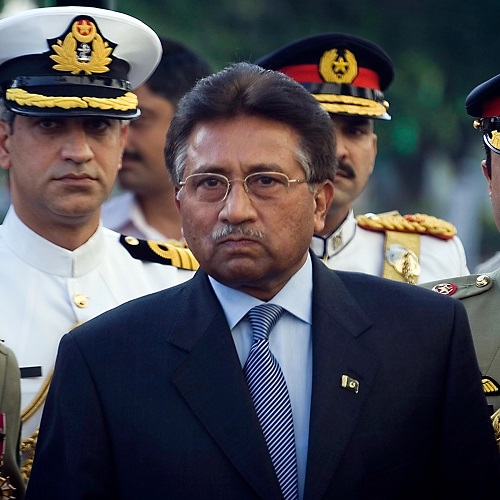
The lower-middle-classes and low-income segments in the urban, peri-urban and rural areas had almost vanished from the public and political discourses. These discourses fell firmly in the hands of the middle-classes, especially when private TV news channels began to proliferate. Even Musharraf’s critics, who appeared on these channels as anchors, largely came from the mentioned class. It was the critical narratives of these critics that created a fissure within the urban middle-classes when it split between the pro-and-anti-Musharraf camps.
The latter camp’s voice grew louder as terrorist attacks increased, the economy began to struggle and Musharraf’s attitude became increasingly haughty, arrogant and dictatorial. This is also why the movement that erupted against him in 2007 was largely populated by middle-income men and women – and it mostly remained rooted in large cities, especially in the Punjab. Despite the fact that he had succeeded in building a constituency for himself, this constituency was politically inexperienced and too raw to counter the growing onslaught against him.
To put it simply, the commotion was mainly between two chunks of the growing middle-classes. The anti-Musharraf chunk found a voice in experienced political players such as the PPP, PML-N, certain Pashtun and Baloch nationalist parties and in lawyers. Even tiny parties such as the PTI jumped on the anti-Musharraf bandwagon.
As a whole, Musharraf’s constituency largely consisted of urban and peri-urban middle-classes. Their numbers had continued to increase from the 1980s onwards. This growth accelerated during the Musharraf dictatorship. It is estimated that the percentage of this group today stands at 38%. When these classes witnessed a split, the anti-Musharraf lot moved towards supporting parties such as the PML-N and the PPP, some regional parties and self-styled ‘leftist’ outfits.
The pro-Musharraf segments of the same classes were politically inexperienced, except in Karachi. This was mainly due to MQM’s overt support towards Musharraf, a fellow ‘Mohajir.’ MQM enjoyed a healthy vote-bank in Karachi and Hyderabad, especially among middle-and-lower-middle-class-Mohajirs. But it could not effectively counter the mostly Punjab-based anti-Musharraf elements dominating the burgeoning electronic media.
During the 2007 anti-Musharraf movement, MQM even went to the extent of accusing Musharraf’s opponents of being anti-Mohajir. The more inexperienced segments of the pro-Musharraf middle-income chunk, on the other hand, had remained apolitical, yet vehement in their support for the general. These were lifestyle liberals, white-collar professionals, businessmen and urban students who were not part of the anti-Musharraf turmoil.
Their retaliation was unique. Like their anti-Musharraf counterparts, they too decided to storm the TV channels to place their mouthpieces. But these were not politicians or political experts, as such. Most of them were articulate conspiracy theorists who began to explain the uprising against Musharraf as a plot by Zionists and Hindus. They portrayed the anti-Musharraf parties as tools of these diabolic plotters.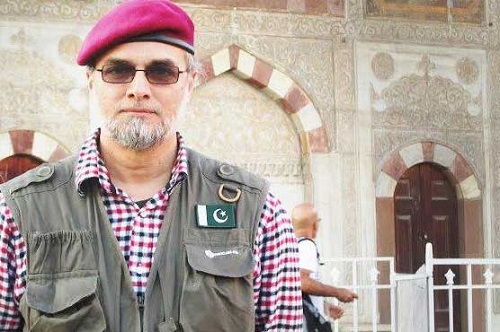
This was a slippery path taken by those who felt that Musharraf’s Enlightened Moderation as it stood till 2006 was not radical enough to counter the narratives of his opponents. They found it to be too soft. So, they began to add elements about Zionist and Hindu conspiracies to it. Now the renaissance bit in Enlightened Moderation didn’t mean advancements in science, philosophy and the arts in the medieval Muslim world, but the military prowess of ancient Muslim empires driven entirely by the passion and power of their faith.
Enlightened Moderation had suddenly taken a rather surreal turn. Even more surreal was the manner in which life-style liberals, white-collar professionals and young men and women were awestruck by this conspiratorial claptrap. Things got even worse when increasing attacks by militant Islamists began to be explained as undertaken by non-Muslim men hired by the CIA!
And so, by the time Musharraf was forced to resign in 2008 (by the PPP and the PML-N), he had gained a surreal constituency. This constituency liked to imagine itself as ‘moderate’ and open-minded – and yet, would obtusely nod their heads at the most fantastical conspiracy theories, most of which had already been convincingly debunked. The constituency became a hodgepodge of bits and pieces plucked from anti-colonial ideas, Islamist ideologues, Muhammad Iqbal, Islamic evangelical groups and outright nut-jobs. This badly digested barrage of splintered information was embraced as ‘knowledge.’
At the centre of it all was a great liking for Musharraf. Or was it? Musharraf flew into exile after his removal. To organise the constituency that he had managed to build, he formed his own political party. He began plotting his return as a significant civilian political player. By 2007, the military that he headed had clearly given up on him. He later lamented that it did not come to his aid when his regime had begun to crumble.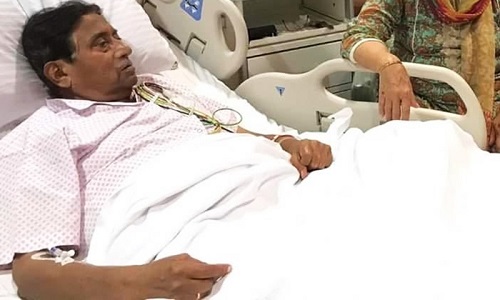
He was conscious of this, but, it seems, he wasn’t aware that the same military establishment had plans to take a ready-made constituency which was his, and put it in the lap of someone else. That someone was Imran Khan. Khan had become the poster boy of the hodgepodge mindset that this constituency had mutated into. The project to aid Khan to lead this constituency began in 2011, but Musharraf claimed that he (Musharraf) had more Facebook followers than Khan!
By 2013, Musharraf began to worry and decided to head back home to claim ‘his people.’ The then military chief Ashfaq Kayani advised him not to return. But he did, expecting to be welcomed by thousands of emotional men and women. He was instead received by only a handful of people. He flew into a rage. And then he was detained.
He was charged with treason. In May 2013, Nawaz Sharif became PM again and was hellbent on dragging a now trapped Musharraf to the courts. After spending a torrid time in Pakistan, Musharraf was finally allowed to leave Pakistan. The constituency had been lost to Khan.
Musharraf cut a lonely, lost and exhausted figure. Years of propping up Khan by the military finally saw Khan become PM in 2018. It was a controversial victory. The constituency that he was gifted wasn’t big enough to give him a major win. So, he stumbled across the four years that he was in power, before he crashed, burned and was ousted by a no confidence vote.
The project burned out. So did the constituency
On February 5 this year, Musharraf passed away in Dubai. Dictators can be cruel. But politics is crueller.
This was a signal from him to the US and European governments: He wasn’t a ‘fundo’; and that Pakistan’s newly-built nuclear devises were in safe hands and in no danger of falling in the palms of groups of officers within the military who had become radicalised, first during the General Zia-ul-Haq dictatorship (1977-88) and then during the tumultuous ‘decade of democracy’ that followed Zia’s demise in 1988.
 At the time of Musharraf’s coup, Pakistan was facing stringent economic sanctions imposed by the US and various European countries. The sanctions were largely slapped in 1998 when PM Nawaz Sharif decided to conduct nuclear tests after India had done the same. The US had offered billions of dollars to Pakistan to not react in this manner to India’s nuclear showmanship. But Nawaz went ahead with the tests. He knew that if he did not, he would be vehemently castigated by the populist Urdu press and Islamist forces, as well as by the military establishment.
At the time of Musharraf’s coup, Pakistan was facing stringent economic sanctions imposed by the US and various European countries. The sanctions were largely slapped in 1998 when PM Nawaz Sharif decided to conduct nuclear tests after India had done the same. The US had offered billions of dollars to Pakistan to not react in this manner to India’s nuclear showmanship. But Nawaz went ahead with the tests. He knew that if he did not, he would be vehemently castigated by the populist Urdu press and Islamist forces, as well as by the military establishment.Musharraf immediately presented himself as someone who would eradicate the ‘unprecedented corruption’ witnessed during the ten years of ‘democracy’ that followed Zia’s demise, and reset the country’s politics and society by mitigating the influence of political Islam and sectarianism that had seeped into the body politic.
He proudly aired his admiration for the founder of the modern Turkish Republic and of Turkish secularism, Kamal Ataturk. He also exhibited similar admiration for former Pakistani military strongman and ‘modernist’ Ayub Khan (1958-69). There wasn’t any immediate reaction to this from a polity exhausted by economic sanctions and the constant three-way political conflict between Sharif’s PML-N, Benazir Bhutto’s PPP and the military establishment.
Cases of vicious sectarian and ethnic violence too had increased across the 1990s, even though their roots firmly lay in the policies of the Zia dictatorship. Musharraf’s coup was celebrated by most people, as reports of smiling men and women distributing sweetmeat began to come in.
Anti-Nawaz politicians weren’t too disturbed by the coup as well. To them, Nawaz had become incredibly arrogant, dictatorial and even delusional after his party had won a two-thirds majority in the 1997 election. Musharraf found himself in a rather comfortable spot, even though US and European governments decided to adopt a more cautious approach. The sanctions stayed.
The Supreme Court allowed Musharraf to rule for up to three years as ‘Chief Executive,’ and military chief. Despite the fact that he did not face any serious opposition from the major political parties who had become exhausted due to the hectic nature of the politics of survivalism that they had to play in the 1990s, Musharraf struggled to revive the economy and the trust of the country’s Western donors and trading partners.
Musharraf promised to ‘bring back’ an era during which – apparently – Pakistan was a modern, prosperous and liberal country. By this, Musharraf meant Ayub Khan’s Pakistan. But for this, he needed a functioning economy and trusting friends in the West. The opportunity to gain these presented itself in the most dramatic manner. 9/11 happened. Renegade Arab jihadists were involved, funded by the one of the most wanted Islamist terrorists, Osama bin Laden.

Osama and his men were operating from Afghanistan which, at the time, was being ruled by the first Taliban regime. That government had been installed by the Pakistani intelligence agencies in 1996. Only three countries were willing to recognise the reactionary Taliban regime: Saudi Arabia, the UAE and Pakistan.
The US government was livid at Osama’s audacity to attack US citizens inside the US. Hundreds perished during the 9/11 attacks. US President George W. Bush gave the green signal to American armed forces to invade Afghanistan, dislodge the Taliban, capture Osama, and install a government of anti-Taliban factions that controlled just ten percent of Afghan territory.
The involvement of Pakistan’s military and intelligence agencies was vital to the plan. Not only did Pakistan share a long border with Afghanistan, but it was heavily involved in Afghan politics after the departure of Soviet troops from Kabul in the late 1980s. Musharraf agreed to facilitate Bush. Pakistan was desperate to renew its relations with the US and European Union countries. What’s more, Pakistan’s involvement would also mean a windfall of aid from the US and the lifting of the 1998 sanctions.
This was a slippery path taken by those who felt that Musharraf’s Enlightened Moderation as it stood till 2006 was not radical enough to counter the narratives of his opponents. They found it to be too soft. So, they began to add elements about Zionist and Hindu conspiracies to it
With relations with European countries and US suddenly improving, sanctions ending and aid starting to roll in, Musharraf was ready to consolidate his position. He had already got himself ‘elected’ as President through a referendum in April 2001, a referendum which he himself joked wasn’t quite transparent. But after 9/11 in September 2001, and renewal of US and European aid and support, Musharraf began to construct a political party which he wanted to dominate the new parliament and provide the President a plethora of constitutional powers.
 Two men, the moderate Barelvi cleric Tahir-ul-Qadri and former-cricket-star-turned-politician Imran Khan, offered themselves to become President Musharraf’s prime minister. Both were heading tiny parties. Musharraf asked them to contest the coming parliamentary election. Meanwhile, Musharraf busied the intelligence agencies to accommodate the Americans in Afghanistan and construct a new political party that was to operate as Musharraf’s civilian vessel.
Two men, the moderate Barelvi cleric Tahir-ul-Qadri and former-cricket-star-turned-politician Imran Khan, offered themselves to become President Musharraf’s prime minister. Both were heading tiny parties. Musharraf asked them to contest the coming parliamentary election. Meanwhile, Musharraf busied the intelligence agencies to accommodate the Americans in Afghanistan and construct a new political party that was to operate as Musharraf’s civilian vessel.Former PML-N members who had had a falling-out with Nawaz were coaxed into joining the new party. Some members from the PPP too were brought in. Thus emerged PML-Quaid (PML-Q). In the erstwhile NWFP that was most impacted by the US bombing and invasion of Afghanistan, Musharraf allowed the formation of a multi-party electoral alliance of mainstream Islamist parties.
It is believed that this was Musharraf’s way of deflecting the criticism that he had begun to face from these parties and ‘allow’ them to absorb the apprehensions souring in NWFP against the US. The PPP and PML-N were in tatters, with their senior leadership either in exile or in jail. State machinery was manoeuvred to ensure a PML-Q win in the 2002 election; and secure a victory in the NWFP for the Islamist alliance. The PPP surprised pundits by winning the second largest number of National Assembly seats. PML-N was routed.
What’s more, so were Imran Khan’s PTI and Qadri’s PAT. This ended their romance with Musharraf. With the help of pro-Musharraf regional parties such as the MQM, National Democratic Alliance, PML-Functional, PML-J, PML-Zia and PPP-Sherpao, it became possible for the PML-Q to form the government in the centre, Punjab, Sindh and Balochistan. The Islamist alliance, the MMA, formed the government in NWFP.
The new parliament bestowed the President with additional powers and the provision to remain as army chief. Musharraf also moved to decrease tensions with India. Till 2006, his regime oversaw a steady growth of the economy which mostly benefitted the fortunes of urban middle-and-upper-middle-classes, even though there were economists who warned that this economy was a neoliberal bubble which was bound to implode.
With the parliament, judiciary and the military on his side, and US aid bolstering him, and relations with India improving, Musharraf seemed to have no opposition. The MMA in NWFP was kept busy to soak up the fall-out of US presence in Afghanistan and try out their precious little morality experiments in that province.
Nevertheless, many militant Islamists who had crossed into Pakistan after the fall of the Taliban in Afghanistan, often inflicted terror attacks. These included assassination attempts against Musharraf. To be sure, Musharraf launched multiple operations against them. Action was also taken against various militant sectarian outfits. However, there is now enough evidence to prove that whereas, on the one hand, the Musharraf regime was going after certain Islamist groups, on the other, the same government was nourishing militant outfits that it believed could be used in Afghanistan and in Indian-held Kashmir.
But this didn’t stop Musharraf from shaping a neo-modernist ‘philosophy’ to describe the ideological tenor of his regime. He called it ‘Enlightened Moderation.’ He announced it through an article that he wrote for the Washington Post. He explained Pakistani society as being inherently ‘moderate,’ but which began to be radicalised during Pakistan’s involvement in the ‘Afghan jihad’ in the 1980s, and by the failure of ‘corrupt’ political parties to stall the growth of sectarian and Islamist outfits in the 1990s.
Musharraf claimed that his government was ready to lead a ‘renaissance’ in the Muslim world by adopting an ‘enlightened moderation’ and/or views focused more on social uplift, justice and progress rather than on ideologies that encourage extremist ideas and actions. He also advised Western powers to understand the nature of anger that Muslims feel when they see injustices against the Palestinians and Kashmiris.
As his idea of Enlightened Moderation evolved, he also added to it his understanding of Sufism. He saw it as a natural bulwark against extremist Islamism. All this was before TLP and Khadim Hussain Rizvi, of course. But by 2006, attacks by extremists had begun to increase and the economy began to slowly slide. Insulated by his sense of having no real political opposition, Musharraf failed to notice a growing sense of unease against his dictatorship. The economy had largely benefited middle-income and upper-middle-class groups in the country’s major urban areas.

The lower-middle-classes and low-income segments in the urban, peri-urban and rural areas had almost vanished from the public and political discourses. These discourses fell firmly in the hands of the middle-classes, especially when private TV news channels began to proliferate. Even Musharraf’s critics, who appeared on these channels as anchors, largely came from the mentioned class. It was the critical narratives of these critics that created a fissure within the urban middle-classes when it split between the pro-and-anti-Musharraf camps.
The latter camp’s voice grew louder as terrorist attacks increased, the economy began to struggle and Musharraf’s attitude became increasingly haughty, arrogant and dictatorial. This is also why the movement that erupted against him in 2007 was largely populated by middle-income men and women – and it mostly remained rooted in large cities, especially in the Punjab. Despite the fact that he had succeeded in building a constituency for himself, this constituency was politically inexperienced and too raw to counter the growing onslaught against him.
To put it simply, the commotion was mainly between two chunks of the growing middle-classes. The anti-Musharraf chunk found a voice in experienced political players such as the PPP, PML-N, certain Pashtun and Baloch nationalist parties and in lawyers. Even tiny parties such as the PTI jumped on the anti-Musharraf bandwagon.
By 2007, the military that he headed had clearly given up on him. He later lamented that it did not come to his aid when his regime had begun to crumble. He was conscious of this, but, it seems, he wasn’t aware that the same military establishment had plans to take a ready-made constituency which was his, and put it in the lap of someone else
Musharraf’s Constituency: Enlightened Moderation takes a Surreal Turn
As a whole, Musharraf’s constituency largely consisted of urban and peri-urban middle-classes. Their numbers had continued to increase from the 1980s onwards. This growth accelerated during the Musharraf dictatorship. It is estimated that the percentage of this group today stands at 38%. When these classes witnessed a split, the anti-Musharraf lot moved towards supporting parties such as the PML-N and the PPP, some regional parties and self-styled ‘leftist’ outfits.
The pro-Musharraf segments of the same classes were politically inexperienced, except in Karachi. This was mainly due to MQM’s overt support towards Musharraf, a fellow ‘Mohajir.’ MQM enjoyed a healthy vote-bank in Karachi and Hyderabad, especially among middle-and-lower-middle-class-Mohajirs. But it could not effectively counter the mostly Punjab-based anti-Musharraf elements dominating the burgeoning electronic media.
During the 2007 anti-Musharraf movement, MQM even went to the extent of accusing Musharraf’s opponents of being anti-Mohajir. The more inexperienced segments of the pro-Musharraf middle-income chunk, on the other hand, had remained apolitical, yet vehement in their support for the general. These were lifestyle liberals, white-collar professionals, businessmen and urban students who were not part of the anti-Musharraf turmoil.
Their retaliation was unique. Like their anti-Musharraf counterparts, they too decided to storm the TV channels to place their mouthpieces. But these were not politicians or political experts, as such. Most of them were articulate conspiracy theorists who began to explain the uprising against Musharraf as a plot by Zionists and Hindus. They portrayed the anti-Musharraf parties as tools of these diabolic plotters.

This was a slippery path taken by those who felt that Musharraf’s Enlightened Moderation as it stood till 2006 was not radical enough to counter the narratives of his opponents. They found it to be too soft. So, they began to add elements about Zionist and Hindu conspiracies to it. Now the renaissance bit in Enlightened Moderation didn’t mean advancements in science, philosophy and the arts in the medieval Muslim world, but the military prowess of ancient Muslim empires driven entirely by the passion and power of their faith.
Enlightened Moderation had suddenly taken a rather surreal turn. Even more surreal was the manner in which life-style liberals, white-collar professionals and young men and women were awestruck by this conspiratorial claptrap. Things got even worse when increasing attacks by militant Islamists began to be explained as undertaken by non-Muslim men hired by the CIA!
And so, by the time Musharraf was forced to resign in 2008 (by the PPP and the PML-N), he had gained a surreal constituency. This constituency liked to imagine itself as ‘moderate’ and open-minded – and yet, would obtusely nod their heads at the most fantastical conspiracy theories, most of which had already been convincingly debunked. The constituency became a hodgepodge of bits and pieces plucked from anti-colonial ideas, Islamist ideologues, Muhammad Iqbal, Islamic evangelical groups and outright nut-jobs. This badly digested barrage of splintered information was embraced as ‘knowledge.’
At the centre of it all was a great liking for Musharraf. Or was it? Musharraf flew into exile after his removal. To organise the constituency that he had managed to build, he formed his own political party. He began plotting his return as a significant civilian political player. By 2007, the military that he headed had clearly given up on him. He later lamented that it did not come to his aid when his regime had begun to crumble.

He was conscious of this, but, it seems, he wasn’t aware that the same military establishment had plans to take a ready-made constituency which was his, and put it in the lap of someone else. That someone was Imran Khan. Khan had become the poster boy of the hodgepodge mindset that this constituency had mutated into. The project to aid Khan to lead this constituency began in 2011, but Musharraf claimed that he (Musharraf) had more Facebook followers than Khan!
By 2013, Musharraf began to worry and decided to head back home to claim ‘his people.’ The then military chief Ashfaq Kayani advised him not to return. But he did, expecting to be welcomed by thousands of emotional men and women. He was instead received by only a handful of people. He flew into a rage. And then he was detained.
He was charged with treason. In May 2013, Nawaz Sharif became PM again and was hellbent on dragging a now trapped Musharraf to the courts. After spending a torrid time in Pakistan, Musharraf was finally allowed to leave Pakistan. The constituency had been lost to Khan.
Musharraf cut a lonely, lost and exhausted figure. Years of propping up Khan by the military finally saw Khan become PM in 2018. It was a controversial victory. The constituency that he was gifted wasn’t big enough to give him a major win. So, he stumbled across the four years that he was in power, before he crashed, burned and was ousted by a no confidence vote.
The project burned out. So did the constituency
On February 5 this year, Musharraf passed away in Dubai. Dictators can be cruel. But politics is crueller.

